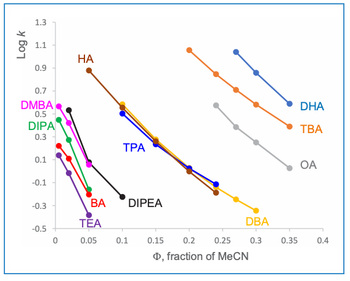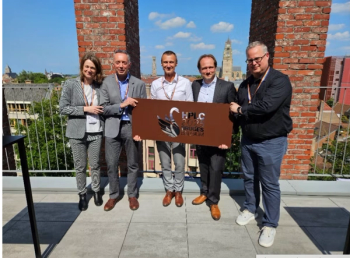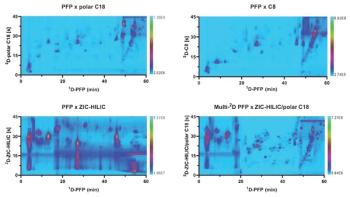Key Points:
- Custom 3D-printed materials significantly reduce background interference in untargeted LC–QTOF-MS.
- Material type and print method influence leachables and data quality.
- Rigorous blank profiling and solvent matching are essential for reliable untargeted analysis.
Untargeted liquid chromatography–quadrupole time-of-flight mass spectrometry (LC–QTOF-MS) workflows are sensitive to background compounds leached from sample-contact materials. We develop and assess novel devices for sample preparation before chromatographic quantification using three-dimensional (3D) printing solutions, but these have only been tested for targeted analysis. In this study, we compared fused deposition modeling (FDM) and digital light processing (DLP) 3D-printed sorbent devices made from commercial and laboratory-developed materials. Our findings demonstrate that the choice of polymer and print technology critically affects blank sample complexity, and custom materials for high-sensitivity lipidomic extractions are recommended.
Advances in three-dimensional (3D) printing have transformed laboratory workflows by enabling on-demand fabrication of customized components, including sorbent-based extraction devices tailored to specific analytical needs (1). Prior studies have demonstrated the feasibility of 3D-printed microfluidic cartridges, sample holders, and even stationary phases for chromatographic separations, largely using fused deposition modeling (FDM) or digital light processing (DLP) techniques (2). However, most reports to date have focused on mechanical performance, fluidics, or targeted assays, with limited attention focused on potential chemical interferences arising from leachable printing materials.
In untargeted liquid chromatography–mass spectrometry (LC–MS) workflows, background contaminants from sample-contact materials can generate thousands of unwanted peaks, complicating data processing and undermining reliable detection of low-abundance analytes (3). While a few groups have highlighted solvent compatibility, comprehensive blank‐profile studies, particularly using high-resolution quadrupole time-of-flight (QTOF) instruments, remain scarce (4). In addition, the majority of investigations have relied on commercial filaments or resins, whose proprietary compositions preclude systematic assessment of chemical components.
Our work addresses these gaps by directly comparing commercial and laboratory-formulated sorbent devices fabricated using both FDM and DLP. We utilized a custom polypropylene/acrylonitrile-butadiene-styrene filament functionalized with C18 silica (PP/ABS-C18), designed in our group for sorptive properties, alongside commercially available LayFOMM 60, a proprietary FDM material. Similarly, we evaluated a laboratory-synthesized DLP resin against an off-the-shelf photopolymer. By subjecting each device to controlled solvent immersions and analyzing extracts with LC–QTOF-MS, we systematically characterized blank complexity in water and organic solvents.
This study is the first to directly compare FDM and DLP sorbents for untargeted LC–MS, using custom-made materials with controlled chemical composition. Our findings provide actionable guidance for researchers seeking to integrate 3D printing into high sensitivity lipidomic and metabolomic workflows, ensuring that material selection does not compromise analytical performance.
Materials and Methods
Chemicals
Deionized water was produced in-house using a HLP5 system (Hydrolab) and used for all sample and solvent preparations; LC–MS-grade methanol, acetonitrile, and isopropanol (LiChrosolv hypergrade; Sigma–Aldrich) were employed for chromatographic separations and sample extractions; ammonium formate (≥99%, LiChropur; Sigma–Aldrich) was used to prepare 5-mM mobile-phase buffers; and HPLC Plus acetone (Sigma-Aldrich) was used for post-processing of 3D-printed parts.
3D Printing and Post-processing
All sorbent devices were printed as hollow tubes (5-mm outer diameter ×10-mm length × 1 mm wall thickness; Figure 1) to ensure direct comparability. Four materials were evaluated: Porolay LayFOMM 60 filament (5), a custom PP/ABS-C18 composite filament comprising polypropylene and acrylonitrile-butadiene-styrene in a 2.5:1 w/w ratio with 15% C18-functionalized silica (6), clear plant-based resin (Anycubic) (7), and a laboratory-synthesized DLP resin containing 60% hydroxyethyl methacrylate, 40% ethylene glycol dimethacrylate, and 4% Irgacure 819 as photoinitiator (HEMA/EDMA resin), prepared following the protocol of Dong and colleagues (8). Each material has previously demonstrated suitability for targeted extraction workflows in the cited studies. Thermoplastic filaments were printed on an i3 MK3 printer (Prusa Research), while resin parts were fabricated on a Photon Ultra DLP printer (Anycubic).
All 3D-printed devices underwent post-print processing to make them suitable for blank extractions. Thermoplastic tubes were activated via porogen removal: LayFOMM 60 tubes were triple-rinsed in purified water (1 h ultrasonic bath per cycle, using fresh water each time), followed by an overnight soak, while PP/ABS-C18 tubes received the identical protocol with acetone replacing water to remove the sacrificial polymer and generate porosity. Resin-based tubes were first rinsed briefly with isopropanol to eliminate uncured resin, support structures were removed, and the parts were then immersed in acetone for 1 h, refreshed with clean solvent, and left to soak overnight. Finally, all tubes were air-dried at room temperature and stored until analysis.
Blank Extraction Experiments
Blank extraction experiments were performed by immersing each 3D-printed sorbent tube in 1 mL of solvent (water, methanol, isopropanol, or acetonitrile) within a glass test tube and agitating at room temperature for 1 h. Each material–solvent combination was prepared in triplicate (n = 3). Upon completion of the incubation, the devices were removed, and the resulting solvent extracts were transferred into LC–MS vials for subsequent QTOF analysis.
LC–QTOF-MS Analysis
Reversed-phase LC–QTOF-MS analyses were performed on an Agilent 1290 Infinity II UHPLC system coupled to an Agilent 6450 QTOF mass spectrometer with Jet Stream ion source (Agilent Technologies). The HPLC system was equipped with a binary pump, online degasser, autosampler, and thermostated column compartment. Separations utilized a 2.1 × 100 mm, 1.7-µm Kinetex EVO C18 column (Phenomenex) fitted with a 0.2-µm in-line filter and held at 60 °C. Mobile phase A was 5 mM ammonium formate in H₂O–MeOH (1:4, v/v) and mobile phase B was 5-mM ammonium formate in isopropanol; flow rate was 0.3 mL/min. The gradient program was 20 → 40% B over 0–20 min, 40 → 60% B over 20–40 min, 60 → 100% B over 40–45 min, held at 100% B from 45–55 min, followed by re-equilibration for 10 min. Electrospray ionization was operated in positive-ion mode (fragmentor 120 V; capillary 5000 V; nebulizer 35 psi; drying gas 10 L/min at 300 °C). Data were acquired in full-scan mode (mass-to-charge ratio [m/z] 200–1700) at 4 GHz resolution, with daily TOF calibration to maintain mass accuracy.
Raw data were processed using the Molecular Feature Extraction (MFE) algorithm in Agilent MassHunter Qualitative 10.0 (ion threshold > 1000 counts; H+ adducts; “common organic” isotope model; charge states 1–2; MFE score ≥ 70). The resulting .cef files were aligned in Mass Profiler Professional 15.1 (Agilent Technologies) using a retention-time tolerance of 0.15 min, a mass-tolerance slope of 15 ppm, and an intercept of 2 mDa. Aligned feature tables (neutral mass, retention time, peak volume) were exported as CSV. Features detected in pure solvent samples or not present in all three replicates were excluded from further data analysis.
Results and Discussion
Rationale for Sorbent and Solvent Selection
The performance of sorbent materials in untargeted lipidomic workflows depends on their chemical inertness. The leachable compounds produce background peaks in LC–QTOF-MS data, and by co-eluting with target analytes, can cause unpredictable matrix effects, such as MS signal suppression, thereby impacting detection of low-abundance lipids.
It is therefore essential to assess, control, and mitigate these interferences. Key metrics include the number of background peaks, their total intensity, and their distribution across retention time and mass-to-charge ratio (m/z) value.
To assess the potential for blank contamination in untargeted LC–QTOF workflows, we selected four sorbent materials that span both established commercial polymers and novel laboratory-synthesized resins, and four solvents representing a broad polarity range. Porolay LayFOMM 60 and a PP/ABS‐C18 composite filament were chosen as representative FDM materials with documented use in targeted extractions, while a plant-based DLP resin and a custom hydroxyethyl methacrylate–ethylene glycol dimethacrylate photopolymer provided insight into resin-derived leachables. Water, methanol, acetonitrile, and isopropanol were employed to interrogate hydrophilic and lipophilic extractables under conditions analogous to typical lipidomics protocols. All printed tubes were fabricated and post-processed reproducibly (see Figure 1), and full details of printer settings, resin formulations, and activation workflows are available in the cited publications.
Number of Background Molecular Features
Table I summarizes the number of molecular features detected for each sorbent–solvent combination. In FDM‐printed devices, Porolay LayFOMM 60 exhibited a very high background in all organic solvents on the order of 970–2400 features per extract. Conversely, the custom PP/ABS-C18 filament released only 150 features under the same conditions (and similarly low counts in water). The low background in the water for LayFOMM extracts likely reflects their prior removal during the water-based rinsing protocol. Overall, the PP/ABS-C18 material reduced feature counts by more than an order of magnitude compared to LayFOMM 60.
Among DLP resins, the commercial plant-based polymer showed pronounced solvent-dependent leaching, with minimal features in water but several hundred in methanol, acetonitrile and isopropanol. In contrast, laboratory-synthesized HEMA/EDMA resin maintained uniformly low feature counts (comparable to PP/ABS-C18) across all four solvents.
Overall, these results demonstrate that custom materials, whether FDM or DLP, provide a substantially cleaner extraction blank profile than their commercial counterparts, making them preferable for untargeted LC–QTOF-MS workflows.
Figure 2 presents the summed peak volumes of all detected molecular features (MFs) for each material–solvent extract, offering an alternative perspective to MF count alone. In FDM-printed devices, LayFOMM 60 exhibited the largest background signal, with total MF peak volumes exceeding 0.7 × 109 a.u. in methanol and acetonitrile and approaching 0.4 × 109 a.u. in isopropanol. By comparison, the PP/ABS-C18 composite filament yielded a total MFs peak volume that was an order of magnitude lower (below 0.1 × 109 a.u.) across all solvents, with minimal variation between organic and aqueous media.
The commercial plant-based resin displayed an intermediate behavior; its total MFs peak volume was lower (≈ 0.2–0.3 × 109 a.u.) in organic solvents, reflecting solvent-dependent leaching of resin components. In contrast,
laboratory-synthesized HEMA/EDMA resin maintained uniformly low total MFs peak volume (≈ 1–2 × 10⁸ a.u.) regardless of solvent, mirroring the performance of PP/ABS-C18. Across three replicates, relative standard deviations for total MFs peak volume remained below 10% for both custom materials, showing consistent, predictable results and reducing concern over variability in total leached MFs.
These observations reinforce a clear performance hierarchy: LayFOMM 60 << plant-based resin < PP/ABS-C18 ≈ lab resin. Importantly, the minimal and consistent total MFs volume of the custom sorbents demonstrates their suitability for untargeted LC–QTOF-MS workflows, where low and predictable background compounds levels are essential for precise detection of lipids.
Figure 3 presents bubble plots in which each molecular feature is marked by an “×” symbol, with marker diameter proportional to mean peak intensity found on chromatograms. For clarity, we present results only for methanol blank extracts. Overlaid at the bottom is a bubble plot of a fetal bovine serum extracellular-vesicle lipid extract obtained by liquid–liquid extraction technique and analyzed with the same LC–MS conditions. The polar-head lipids (glycerophospholipids and sphingolipids) elute before 25 min (m/z 600–900) and more lipophilic compounds, such as triacylglycerols (TG) and cholesterol esters, elute after 30 min (m/z 850–950).
In the LayFOMM 60 extracts, dense clouds of large “×” markers appear early (< 25 min) at low m/z (200–400 Da), directly overlapping the phospholipid region and indicating substantial risk of background interference. By contrast, both PP/ABS-C18 and the lab-synthesized resin show only a handful of small “×” markers in this window, suggesting minimal impact on polar-lipid detection. In the late-eluting TG region (> 30 min), the commercial plant-based resin again produces a band of mid-sized markers, whereas the custom C18-functionalized materials remain virtually free of detectable features.
These observations confirm that while leachables from commercial polymers can appear in both polar and neutral lipid elution windows, custom-made PP/ABS-C18 devices offer markedly cleaner baselines.
Conclusions
This study demonstrates that 3D-printed sorbent devices can
be successfully integrated into untargeted LC–QTOF-MS lipidomic workflows, provided that material choice, solvent selection, and blank-profiling protocols are carefully managed. Although all tested polymers and resins leach detectable compounds when extracted in organic solvents, our quantitative and visual analyses show that these leachables do not necessarily compromise the key lipid windows, especially when custom materials are used and appropriate controls are in place.
Porolay LayFOMM 60 and the commercial plant-based DLP resin exhibited the highest background complexity and total MS signal for compounds detected in methanol, acetonitrile, and isopropanol, with dense clusters of low- and mid-mass features overlapping the elution regions of phospholipids (tr < 25 min;
m/z 600–900) and triacylglycerols (tr > 30 min; m/z 850–950). By contrast, the PP/ABS-C18 composite filament and lab-synthesized HEMA/EDMA resin showed uniformly low feature counts and total MFs peak volume across all solvents, with only sparse, low-intensity peaks even in the most aggressive solvent. These custom materials therefore afford a “clean” background that preserves both sensitivity and accuracy in untargeted analyses.
Solvent choice proved to be a critical factor: Feature count, total signal, and the mass/retention-time distribution of leachables varied markedly between water, methanol, acetonitrile, and isopropanol. Accordingly, we recommend that analysts validate their sample-preparation solvent system against blank-extraction profiles for each 3D-printed material they intend to use. In practice, extracting devices in the same solvent(s) planned for sample processing, running solvent-specific blanks in triplicate, and incorporating these blank data sets into downstream filtering or blank-subtraction algorithms will effectively mitigate residual interferences.
Based on these findings, we advise against using unmodified commercial filaments or resins for untargeted lipidomics without rigorous blank characterization. Instead, custom devices, fabricated by FDM or
DLP with specially developed materials, offer a robust alternative, combining low leachability. A simple pre-use cleaning protocol (for example,
ultrasonic rinse in methanol or acetone, followed by an overnight soak) further reduces blank levels to negligible values.
Looking forward, expanding this approach to additional polymer–solvent combinations, developing novel materials and post-processing protocols, and integrating automated blank filtering within data-processing pipelines will enhance confidence in trace-level lipid detection.
Taken together, our data underscore that with the right materials and quality control measures, 3D-printed sorbent devices can be a powerful and cost-effective tool for untargeted LC–QTOF-MS lipidomics.
References
(1) Belka, M.; Bączek, T. Additive Manufacturing and Related Technologies: The Source of Chemically Active Materials in Separation Science. TrAC 2021, 142, 116322. DOI: 10.1016/J.TRAC.2021.116322
(2) Salmean, C.; Dimartino, S. 3D-Printed Stationary Phases with Ordered Morphology: State of the Art and Future Development in Liquid Chromatography. Chromatographia 2018, 82 (1), 443–463. DOI: 10.1007/S10337-018-3671-5
(3) Dudzik, D.; Barbas-Bernardos, C.; García, A.; Barbas, C. Quality Assurance Procedures for Mass Spectrometry Untargeted Metabolomics. A Review. J. Pharm. Biomed. Anal. 2018, 147, 149–173. DOI: 10.1016/J.JPBA.2017.07.044
(4) Zhou, W.; Lan, Q.; Dutt, M.; Pawliszyn, J. 3D Printed Coated Blade Spray-Mass Spectrometry Devices. Anal. Chem. 2024, 96, 16520–16524.DOI: 10.1021/acs.analchem.4c04613
(5) Belka, M.; Ulenberg, S.; Ba̧czek, T. Fused Deposition Modeling Enables the Low-Cost Fabrication of Porous, Customized-Shape Sorbents for Small-Molecule Extraction. Anal. Chem. 2017, 89, 4373–4376. DOI: 10.1021/acs.analchem.6b04390
(6) Szynkiewicz, D.; Ulenberg, S.; Georgiev, P.; et al. Development of a 3D-Printable, Porous, and Chemically Active Material Filled with
Silica Particles and its Application to the Fabrication of a Microextraction Device. Anal. Chem. 2023, 95, 11632–11640. DOI: 10.1021/acs.analchem.3c01263
(7) Georgiev, P.; Belka, M.; Kroll, D.; et al. 3D-printed Extraction Devices Fabricated from Silica Particles Suspended in Acrylate Resin. J. Chromatogr. A 2024, 1717, 464671. DOI: 10.1016/J.CHROMA.2024.464671
(8) Dong, Z.; Cui, H.; Zhang, H.; et al. 3D Printing of Inherently Nanoporous Polymers via Polymerization-induced Phase Separation. Nat. Commun. 2021, 12 (1),1–12. DOI: 10.1038/s41467-020-20498-1
Dagmara Kroll is a PhD candidate working under the supervision of Tomasz Bączek and Mariusz Belka at the Department of Pharmaceutical Chemistry (Medical University of Gdańsk). She obtained a master’s degree in pharmacy in 2020. Her current research focuses on developing new sample preparation methods involving 3D printing and functional materials for solid-phase extraction.
Bartosz Marciniak is a PhD researcher at the Department of Pharmaceutical Chemistry (Medical University of Gdańsk). He obtained his PhD in chemistry at Adam Mickiewicz University in Poznań (Poland). His current research focuses on applications of DLP 3D printing in pharmaceutical analysis, sample preparation, and chromatography.
Michał Młynarczyk is a PhD candidate in the Department of Analytical Chemistry at Gdańsk University of Technology, where he focuses on bioanalytical research. His work focuses on lipidomics and the application of chromatographic techniques to the study and separation of biomolecules.
Weronika Hewelt-Belka works as an associate professor at the Department of Analytical Chemistry, Faculty of Chemistry, Gdańsk University of Technology. Her research focuses mainly on the development and application of new methods for lipidomic analysis using advanced hyphenated techniques. She currently leads an NCN project aimed at the development of new LC–MS-based tools for the separation and lipidomic characterization of extracellular vesicles.
Mariusz Belka works as an assistant professor at the Department of Pharmaceutical Chemistry (Medical University of Gdańsk). His research focuses on developing new sample preparation methods involving 3D printing, bioanalytical, and environmental method development, with LC–MS and GC–MS as leading techniques. He has authored over 70 peer-reviewed publications.





